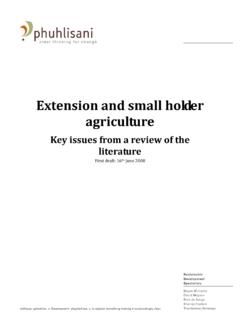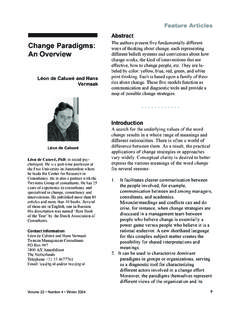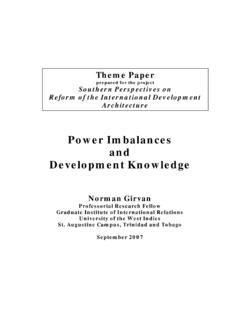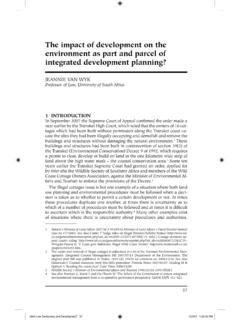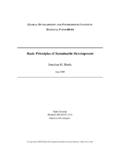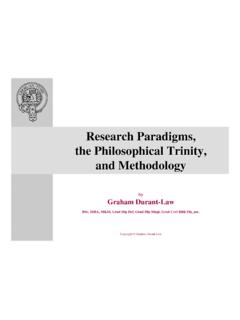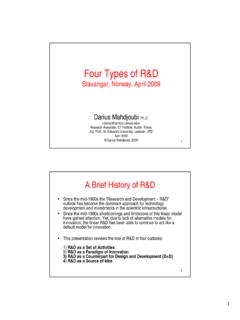Transcription of International and local approaches to rural …
1 International and local approaches to rural development Key issues and questions: A review of the literature for the Drakenstein Municipality Phuhlisani Solutions: September 2009 Phuhlisani Solutions: September 2009 1 y International and local approaches to rural development Key issues and questions: A review of the literature for the Drakenstein Municipality Contents CONTENTS .. 1 BACKGROUND .. 3 THE STRUCTURE OF THE REVIEW .. 3 CONTESTED GLOBAL development PARADIGMS .. 3 MODERNISATION THEORY .. 4 Marxist development theory .. 5 More similarities than differences .. 5 Globalisation .. 6 The sustainable development imperative .. 6 SUMMARISING THE PARADIGM SHIFTS .. 8 LOCATING rural development IN WIDER development DISCOURSE .. 8 DEFINING rural development .. 9 EVOLVING IDEAS AND approaches TO rural development INTERNATIONALLY.
2 9 1950 s .. 10 1960 s .. 10 1970 s .. 11 1980 s .. 12 1990 s .. 13 2000 s .. 14 REFLECTIONS ON THE CHRONOLOGY .. 17 development AND rural AREAS IN SOUTH AFRICA PRE 1994 .. 18 LAND DISPOSSESSION .. 18 TWO AGRICULTURES? .. 20 HISTORICAL MEASURES TO STRENGTHEN THE WHITE COMMERCIAL FARMING 20 HISTORICAL MEASURES TO REGULATE PRODUCTION AND LAND USE IN THE RESERVES AND THE HOMELANDS .. 20 THE HOMELAND ERA .. 21 DBSA farmer support 21 rural development IN SOUTH AFRICA POST 1994 .. 22 REVISITING ASSUMPTIONS ON rural URBAN LINKAGES .. 23 THE rural development STRATEGY OF THE GOVERNMENT OF NATIONAL UNITY .. 24 rural development FRAMEWORK (1997) .. 25 THE INTEGRATED SUSTAINABLE rural development STRATEGY (2000).. 26 LINKING LAND REFORM, AGRICULTURE AND rural development .. 29 Phuhlisani Solutions: September 2009 2 y TIPS.
3 29 Settlement and Implementation Support Strategy for Land and Agrarian Reform .. 30 Guidelines for Delivering Effective Settlement and Implementation Support for Land Reform in the Western Cape .. 33 NEW AGRICULTURAL POLICY .. 34 Rethinking the two agricultures thesis .. 34 The need for a more nuanced understanding of agriculture and rural livelihoods .. 36 Retraining extension staff .. 36 Assessing extension effectiveness .. 38 Developing an appropriate extension approach .. 38 The state of the extension service .. 39 Extension staff employed per province .. 39 Extension support to land reform .. 39 THE SECOND ECONOMY STRATEGY .. 40 THE COMPREHENSIVE rural development PROGRAMME .. 41 OVERARCHING QUESTIONS .. 44 CONCLUSION .. 45 REFERENCES .. 46 Phuhlisani Solutions: September 2009 3 y Background The newly elected South African government has adopted a renewed and focused attempt to facilitate and promote rural development which all spheres of government are required to understand and orientate their programmes to correlate with this focus.
4 The Drakenstein Municipality has responded to this call and has developed a draft rural development Strategy with an associated implementation programme. To enable reflection on the strategy development process and the priorities it has identified, the Municipality has commissioned a comprehensive literature review on issues of rural development . The structure of the review This literature review is anchored by five questions: How has thinking about development changed over time? What can we learn from the different approaches that characterise the International experience of rural development ? What can we learn from how South Africa has approached rural development pre and post 1994? What are the key livelihood and employment opportunities for the rural poor? What are the key issues of relevance to the Drakenstein Municipality?
5 To address these questions we: Sketch changing global development paradigms; Map changing approaches and thinking about rural development priorities internationally; Review key issues and concepts associated with rural development theory and practice; Provide a critical history of rural development initiatives in South Africa; Identify the principle components of strategies designed to make rural development happen; Examine the fit between the key findings of the literature and the priorities of Drakenstein Municipality as expressed through its IDP and draft rural development Strategy document. Contested global development paradigms As we will examine the concept of development is not neutral but continues to be fundamentally contested. The primary purpose of the development text (like most others) is to convince, to persuade, that this (and not that) is the way the world actually is and ought to be amended.
6 But ideas about development do not arise in an institutional or literary vacuum. They are rather assembled within a vast hierarchical apparatus of knowledge production and consumption sometimes known development industry . This industry is itself implicated in the operation of networks and of power and domination that in the Twentieth Century have come to encompass the entire globe. (Crush, 1995: 5) The concept of development gained particular prominence in the period following World War 2. Gustavo Esteva dates the appearance of the new development era to 2oth January 1949 when President Harry Truman took office as the post war US President and promised a bold new for the improvement and growth of underdeveloped areas. (Esteva, 1993: 6) This formalised a distinction between Phuhlisani Solutions: September 2009 4 y developed countries and other poor countries primarily in the South which were deemed to be underdeveloped.
7 Historically the discipline of development studies, in which rural development plays a key part, combines two elements: how to promote economic growth, and how to overcome poverty in the global South. (Bernstein, 2005) The underlying assumption in Truman s speech, and of the development policies and programmes which followed, was that the impoverished nations of the South should seek to emulate the industrial growth path of the North. This concept of development cannot be separated from the idea that all people of the planet are moving along one single track towards some state of maturity exemplified by the nations running in front . (Sachs, 1993: 3) However in the post war period development ideologies were highly contested and overlaid with the geo-politics of the Cold War. Both the West and the East advocating capitalism and communism respectively, competed to be the nations and systems running in front.
8 Two broad approaches to development theory vied for supremacy. These were: modernisation theory; theories associated with a Marxist critique of economy and society and advancement of socialist development . 1 Modernisation theory Modernisation theory originated with US economists and was promoted by the Bretton Woods Institutions2 established after World War 2. The theory held that growth and capitalist led development was the solution to poverty. This development was premised on Western investment and underpinned by the transfer of technology. It envisaged an evolutionary development process for countries in the South which would mimic the economic growth path taken by the capitalist North. Early economic development theory equated " development " with growth and industrialization. As a result, Latin American, Asian and African countries were seen mostly as "underdeveloped" countries, "primitive" versions of European nations that could, with time, "develop" the institutions and standards of living of Europe and North America.
9 (The New School, 1998) The most crude example of this approach is provided by Rostow who assumed that traditional societies would eventually climb up the evolutionary ladder to enter the age of high mass consumption. (Rostow, 1960) Early modernisation theorists focused almost entirely on economic growth and capital accumulation models and were largely dismissive of the socio-cultural values of societies in the South, characterising these as obstacles to development . Unsurprisingly the prescriptions of modernisation theory and its neo liberal successors have remained highly contested in the South. 1 It is beyond the scope of this review to provide detail on the many different theoretical schools which proliferated under these broad headings.
10 2 The International Monetary Fund and the International Bank for Reconstruction and development established in 1945 Phuhlisani Solutions: September 2009 5 y Later economic theorists came to recognise that development was a social phenomenon that involved much more than increasing per capita output and involved eliminating poverty, unemployment and inequality as well.(Seers, 1989). However economic growth remained the founding assumption, although the focus shifted to how to better redistribute economic benefits. In practice growth-led agricultural and industrial development , irrespective of its ideological packaging or historical era, has had significant social, economic and environmental costs when seen through a global lens. The promised trickle down effect which was premised on economic and social benefits percolating down to the poor largely failed to materialise.
